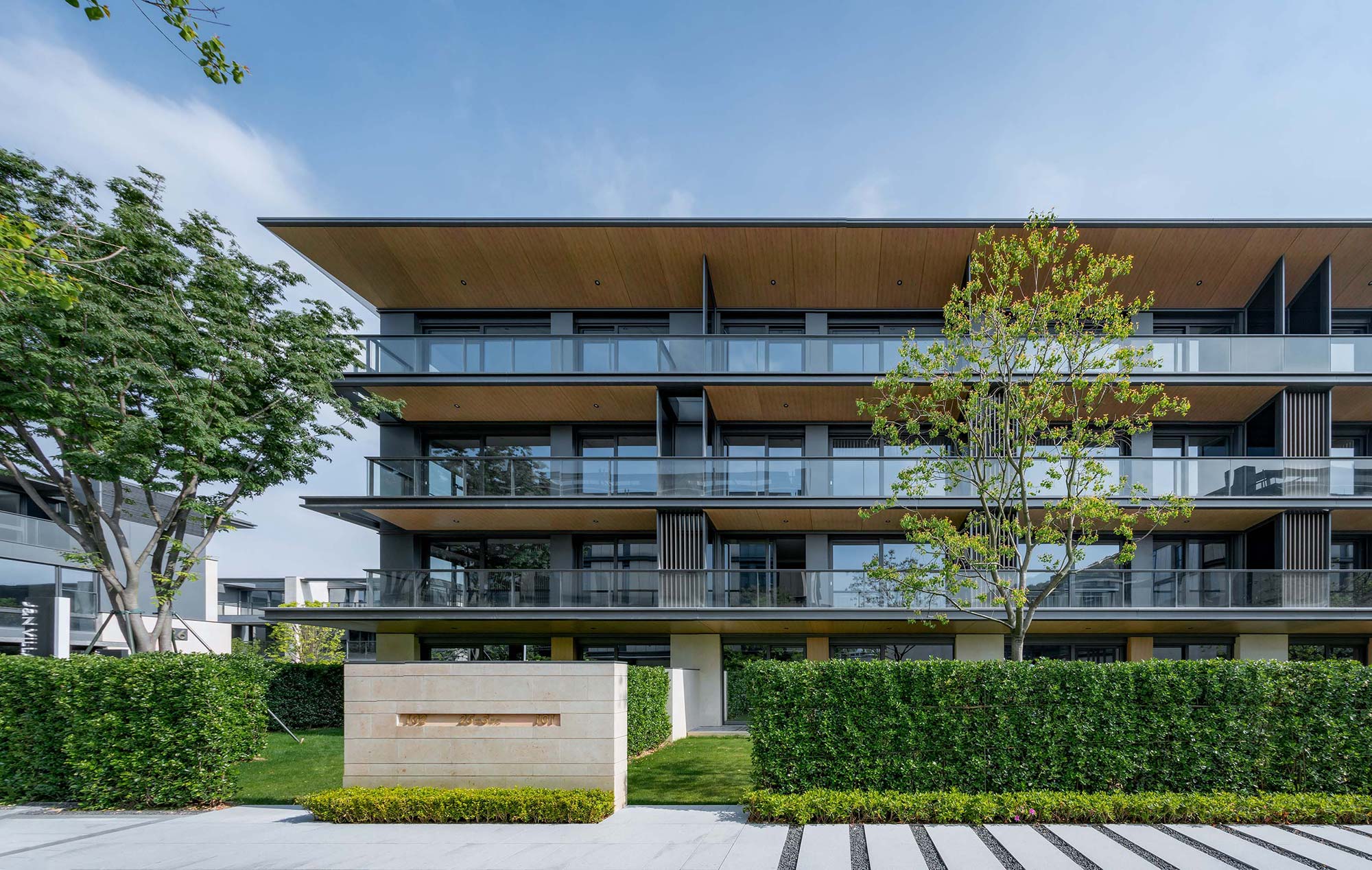江南墅位于台州中央商务区,整体容积率在1.5,是台州市内为数不多的商务区中的低密开发项目。开发商朗成是一家具有家具研制生产背景的、极具技术实力的公司,在其带领之下,项目的建筑、景观、室内各团队深度融合,工作流程已经很大程度上接近“一体化”开发项目的方式,保证了设计的价值在最大程度上的实现。
规划格局中,建筑师自北往南依次安排25层高的高层、8层的洋房、叠墅及院墅。北侧的高层与洋房自成一个围合组团,与南侧的墅区之间体现了“共享且独立”的原则。良好的可达性、景观设施使得高层区域的地面花园成为整个社区中的绿色之肺和阳光空间,提供泳池、健身、户外聚会等设施;而南侧墅区静谧的、亲密尺度的街巷也可为整个社区中的人们共享。
在满足合理的规划格局之上,江南墅力图实现独属于该社区的审美氛围。“在现代主义审美框架之下,融入中国传统建筑空间的韵味。”整体格局在分区的基础上,以非对称图形强化自由丰富的感受,如北侧的三角形花园、东部的楔形街巷空间等。局部场景的刻画上,融入了对于中国园林的思考。例如南侧入户序列为二进院落,整个入户序列深约70米宽约30米,建筑师在这里塑造了一串类同度假酒店入场前区的行进体验,框景、游廊等手法的运用借鉴了东方传统中对于自然的观游态度。
建筑立面设计延续了对上述审美原则的演绎。高层、多层建筑立面以几何形的组合关系表达直白、简洁的现代主义审美,装饰性语言则被减到最小。材料选择方面,建筑师在现代化的建筑材料玻璃、铝板的基础上以暖色的、有着自然属性的材料点缀局部。例如暖色的仿木板应用于高层住宅的外框、叠墅的屋檐底部,在冷峻的工业化表情之中加入了地域和人文的气息。
叠墅户型占总体开发中的大多数。建筑师在叠墅户型中进行微创新,追求为每个分户提供更为极致的通透感、更可用的户外空间。例如上叠户型中的露台位置与其他功能具有良好的分隔关系,实现了与主人私密区域的有效分离。这样的尝试,体现了建筑师在户型设计中精细化思考的态度,以具体场景为思考单位进行“可用性”“易用性”的推敲,而不满足于简单的功能覆盖。
Located in the central business district of Taizhou with an overall plot ratio of 1.5, The Jiangnan Villa is one of the few low-density projects in the central business district of Taizhou developed by Langcheng, a company with strong technical strength and background in furniture development and production. Under its leadership, the teams in charge of the project's architecture, landscape, and interior are deeply integrated, and the work process has been close to "integration" to a large extent, ensuring that the value of the design is realized to the greatest extent.
In the planning pattern, the architect arranged 25-storey high-rises, 8-storey western-style houses, stacked villas and villas with courtyard in sequence from north to south. The high-rises and the western-style houses on the north side form an enclosed cluster, which embodies the principle of "sharing and independence" with the villa area on the south side. Good accessibility and landscape facilities make the ground garden in the high-rise area a green lung and sunny space in the entire community, providing facilities such as swimming pools, fitness, and outdoor gatherings. And the quiet, intimate streets and lanes of the villa area on the south side can also be shared by people in the entire community.
On the basis of meeting the reasonable planning pattern, The Jiangnan Villa strives to achieve an aesthetic atmosphere unique to the community. "Under the modernist aesthetic framework, it integrated the charm of traditional Chinese architectural space." The overall layout based on zoning uses asymmetric graphics to enhance a sense of freedom and diversity, such as the triangular garden on the north side and the wedge-shaped street space on the east side. The depiction of local scenes is integrated with the thinking of Chinese gardens. For example, the entrance sequence on the south side is a two-entry courtyard, and the entire entrance sequence is about 70 meters deep and about 30 meters wide. Here, the architect has created a series of traveling experiences similar to the resort hotel’s entrance area. The use of frame view, veranda and other techniques draws lessons from the Oriental traditional viewing attitude towards nature.
The architectural façade design continues the interpretation of the above aesthetic principles. The façade of high-rises and multi-storey buildings expresses the straightforward and concise modernist aesthetics with the combination of geometric shapes, while the decorative language is minimized. In terms of material selection, architects used warm-colored materials with natural attributes to embellish the parts on the basis of modern building materials such as glass and aluminum panel. For example, warm-colored wood-imitation boards are applied to the outer frame of high-rises and the eave bottom of stacked villas, lending a regional and humanistic flavor to the cold expression of industrialization.
Stacked villas account for the majority of the project developed. The architects carried out micro-innovation in the layout of the stacked villas, pursuing to provide each household with a more extreme sense of transparency and more usable outdoor space. For example, the location of the terrace in the superimposed villa is well separated with other functions, realizing an effective separation from the private area of the owner. Such an attempt reflects the architect's attitude of refined thinking in the design of the apartment, using specific scenes as the thinking unit for "usability" and "easy-to-use" considerations, rather than being satisfied with simple function coverage.
业主 Client
台州市朗成景隆房地产有限公司 LCJL
所在地址 Location
浙江省台州市 Taizhou, Zhejiang
建筑规模 GFA
288750㎡ 288750㎡
项目类型 Type
居住 Residencial
设计范围 Design scope
建筑 Architectral
设计周期 Design period
2018 - 2021



